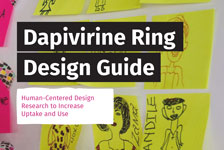- What We Do
- Agriculture and Food Security
- Democracy, Human Rights and Governance
- Economic Growth and Trade
- Education
- Ending Extreme Poverty
- Environment and Global Climate Change
- Gender Equality and Women's Empowerment
- Global Health
- Cross-Cutting Areas
- Emerging Pandemic Threats
- Family Planning
- HIV and AIDS
- Health Systems Strengthening
- Malaria
- Maternal and Child Health
- Neglected Tropical Diseases
- Nutrition
- Tuberculosis
- Water and Sanitation
- Working in Crises and Conflict
- U.S. Global Development Lab
Human-centered design (HCD) is a way of thinking that places the people you're trying to serve and other important stakeholders at the center of the design and implementation process. HCD was developed in the private sector to integrate business and technology around human needs.
Global health faces significant hurdles that stem from the complexity of navigating and coordinating stakeholder ecosystems, the difficulty in changing beneficiaries’ behaviors, the barriers in scaling compelling solutions, and the challenge of appropriately measuring impact. HCD is well suited to tackle these issues by actively engaging beneficiaries, providers, and other constituencies throughout the development process to ensure that their needs and expectations inform design decisions and lead to a higher likelihood of adoption and lasting human impact.
USAID’s Center for Accelerating Innovation and Impact (CII) is supporting the use of HCD across the Bureau for Global Health's work. The below resources provide examples and more information on this work.
CII's HCD Website

ENGAGE HCD
A CII website highlighting ways in which HCD can be effectively applied across USAID's global health work
Resources/Examples

The Dapivirine Ring Design Guide
Includes:
- Human-centered design guide [PDF, 6.8MB] to increase the adoption and sustained use of the dapivirine ring – the first long-acting woman-controlled method for reducing the risk of HIV infection – in sub-Saharan Africa
- Supplementary asset library that provides resources, such as editable templates, for select design concepts:
- Dapivirine Ring Asset Library Part 1/2 [ZIP, 14MB]
- Dapivirine Ring Asset Library Part 2/2 [ZIP, 25MB]

Driving Demand for Chlorhexidine
Includes:
- A human-centered design guide [PDF, 10MB] for the development of demand generation materials
- Supplementary asset library that provides editable templates for select design concepts:







Comment
Make a general inquiry or suggest an improvement.